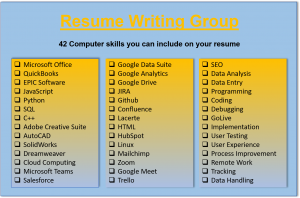In this article, we’ll cover everything you should know about displaying computer skills on your resume (and elsewhere) to successfully land a new job.
Computer skills are a type of technical skill that center around using a computer or form of software. You might already be aware of the term “computer literacy” which simply is a way to describe one’s ability to use a computer, tablet, or mobile device. In most cases, this includes researching, sharing, evaluating, and manipulating information in one form or another. Your computer skills are the necessary tools and methods that enable you to accomplish these tasks. Like any other skill, they’re valuable at showcasing why a potential employer should hire you – or pay you a higher salary.
PCMag’s encyclopedia describes computer literacy as the “hands-on ability to work the operating system (Windows, Mac, Linux) and common applications such as spreadsheets, word processors, database programs, personal information managers (PIMs), email programs and Web browsers.”
There are a wide range of computer skills, and everyone has a different degree of computer literacy. These skills can include everything from simply forwarding an email to writing highly technical software code. However, most people land in the middle.
Computer skills are a critical asset to any job these days because they’re necessary to communicate efficiently, organize information, and maximize productivity. With Covid-19 shifting workforce paradigms toward remote work, you could make the argument that computer skills are becoming even more necessary. Therefore, professionals who can effectively showcase their computer literacy on a resume are more likely to succeed.
With that being said, just about every job requires a basic understanding of computers. In the modern workforce, computers are used to track hours, make schedules, order inventory, and connect with both colleagues and customers. In addition to these basic computer skills, there are also more specialized skills requiring training and practice. Often, these skills are learned through a bootcamp, seminar, class, or even through hands-on experience with a previous employer. Although not everyone will need this specialized computer knowledge, having an understanding of computer uses can make you a more effective employee by giving you the insight you need to communicate clearly with those who do.
If you don’t have some of these skills, but would like to learn, there are many great resources. Here is a list of some of the most common computer courses: Computer Basics
42 computer skills employers look for on a resume

How do people use computer skills in the workforce?
1. To communicate
The most common use of computers is communication. Basic computer skills with tools like Slack, Microsoft Teams, Google Meet, Confluence, and Zoom are necessary for almost any position. Additionally, having a preliminary understanding of email and file browsing is also going to be necessary for most positions. Additionally, depending on the types of positions you’re interested in, you may also need to use software like Asana, Monday, Trello, ClickUp, and Kanbanize. Or – if you’re developing presentations, such as for sales or project-focused roles, you may need to use tools like Google Slides, PowerPoint, and Keynote.
In addition to these skills, you’ll also likely want to have a basic proficiency with Microsoft Office products and Google Suite, such as Microsoft Word, Microsoft Excel, and Google Docs. Skills like these can be complimented with specialized software experience, such as MailChip or Mailgun, which are commonly used for marketing professionals.
2. To organize information
Organizing information clearly and succinctly in an accessible format is an invaluable resource for most companies. Furthermore, if you work with customers on a regular basic, you’ll likely need to be familiar with software like Salesforce and/or HubSpot. Or, if you commonly work with websites, you’ll likely use tools such as Airtable, Google Data Studio, and Tableau.
With any of these software tools, you may also want to discuss the individual tasks you can preform with them if it’s not immediately obvious. For example, creating detailed reports, pivot tables, macros, plugins, and dashboards are some of the individual skills you may want to showcase.
Along with showcasing these individual skills, don’t forget to explain the value of the functions you can complete with them. For example, performing risk assessments, creating revenue projections, and accurately tracking budgets or inventory are all valuable tasks to most employers.
3. To research online
Effectively researching topics to find useful information involves more than basic search skills. You’ll need to know how to synthesize data into usable information, how to find reliable sources, and how to condense searches into actionable insights. Being able to fact check information, use specific search teams, and compile additional resources are all useful research skills that you may want to include in your resume.
4. To build websites, apps, or systems
With computers becoming an ever more present facet of human existence, the ability to create the software those devices operate on is becoming more essential. Understanding how websites and software are created can be a great benefit to bloggers, graphic designers, marketers, and advertisers. Furthermore, understanding how an application is created is very useful for product managers, executive teams, and the sales professionals selling the applications.
Therefore, knowledge of programming languages like C#, C++, PHP, SQL, JavaScript, and Python are critical. Additionally, related software like Azure, Dreamweaver, and Publisher are valuable for showing hiring managers the types of projects you can handle.
If these sound a bit technical for you, but you’re still interested in expanding your knowledge base, no-code building tools like Bubble or Notion may be worth learning more about. The trend toward no-code or low-code is becoming increase popular. What’s more, learning how to use these tools can be a great steppingstone toward some of the more technical aspects of coding.
How to list computer skills on your resume
Crafting a finely-tuned skills section on your resume can actually be more difficult than it sounds. Too often, at Resume Writing Group, we see lists of skills that are poorly organized, confusing to read, and waste too much space on the page. Your list of skills should only include your most relevant skills rather than every skill you have. When properly executed, these sections should be neat, to the point, and informative to read.
Here are a few of the different formats you can use:
The bulleted list
Bulleted lists of skills are the most common on resumes. These sections usually have a heading called “core competencies” or “key areas of expertise.” Bullets are a useful way of organizing information and calling attention to it at the same time. There are a few quick rules of thumb that you should stick to when using bulleted lists: don’t include more than three columns; make sure all columns are even; include at least three, but no more than five, skills in each column.
A bulleted list set up with three columns including five skills each is a great way to save space on the page, organize your information, and present it in a digestible format for employers who are reading the resume quickly.
The bar list
Another option that enables you to include more skills is the bar list. These are skills separated by a dash, hyphen, slash, or comma. They’re useful for including a lot of skills in a small amount of space. However, you should only use this type of list if there is no room for a standard bulleted list. Bar lists can be difficult to read and can actually turn employers off from your resume!
The technical skills section
Separating hard skills from soft skills into different sections is an effective way of organizing your resume into an easy-to-read format. Using multiple skills sections is often useful if you’re in a technical field that requires you to be proficient with a wide range of computer skills.
Where to include computer skills on resume
Beyond simply creating lists of skills, you should also work your computer skills into the actual content and descriptions of your document. Employers prefer this format because it often gives them a clearer picture of where and when you used your skills.
Career profile
Including your most valuable computer skills (the ones you think are most important for the position you’re applying to) in your career profile ensures they’ll be seen by a potential employer. You should balance out these skills with accomplishments and descriptions of important responsibilities. For example:
- Built brand value by utilizing PowerPoint to deliver engaging presentations to high-profile customers on products meeting their needs
Resume headline
A resume headline is an even more impactful way of showcasing your computer skills. However, this method should only be used if your skills are strictly relevant and essential to your career goals. You should not include basic skills like Microsoft Office or Google Suite in your headline.
Work experience
—-
When possible, you should always endeavor to explain how your computer skills tie in with your actual work responsibilities.
Pro Tip: Always try to tie in a result if you can.
For example:
“Employed a comprehensive knowledge of Google Analytics to organize data into actionable insights that drove a 200% increase in ecommerce conversion rates.”
For more advice on writing effective bullet points, check out the 5 Component’s of a Successful Resume
Education
If you’re a recent graduate, you would strive to include your courses and relevant coursework in your education section. This coursework can encompass computer skills that you learned during your education.
Certifications
Certifications – especially those that are computer-centric – are a great way of increasing response rates. Furthermore, they can even make the difference in an upcoming interview by setting you above other candidates who may have the same experience you do but lack the certifications. If you don’t have any certifications, you might think about taking one of LinkedIn’s popular certificate courses.
If you DO have certifications, you can showcase them by creating a separate “certifications” section on your resume.
In this section, you should include the certificate’s title, issuing entity, and the year it was issued. If there is an expiration date, that should also be included for reference. Some of the most common certificates include Lean Six Sigma, Agile, and Waterfall.
How to include computer knowledge in cover a letter
Including computer skills in your cover letter can add a lot of value for potential employers. Your cover letter should never be boring! Instead, try to work some of your computer skills into your descriptions in the same manner as your resume. For example:
“While completing a multimillion-dollar project, I worked extensively with Microsoft Project for managing timelines and key performance indicators.”
For more tips on writing a great cover letter, check out this article.
How to include computer skills on LinkedIn
LinkedIn is a great resource for any professional because it acts as a marketing tool for your resume that any employer can find. However, your LinkedIn profile can only be a great resource if you set it up correctly. Ensuring that your LinkedIn is filled out, looks nice, and kept updated is essential if you want to hear from employers. To do this, you should add a customized URL, nice-looking background photo, and your computer skills. Currently, LinkedIn allows you to add up to 50 skills; however, you can also add certificates and job descriptions to include more of your computer expertise.
Summary
Now that you’ve read about some of the most common computer skills and how they can add value to your career, you can begin working them into your career-related documents. If you need help with your resume, cover letter, or LinkedIn profile, think about hiring a professional resume writer.


